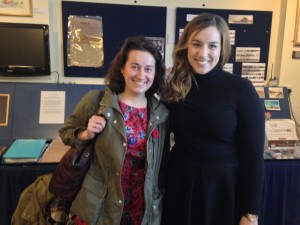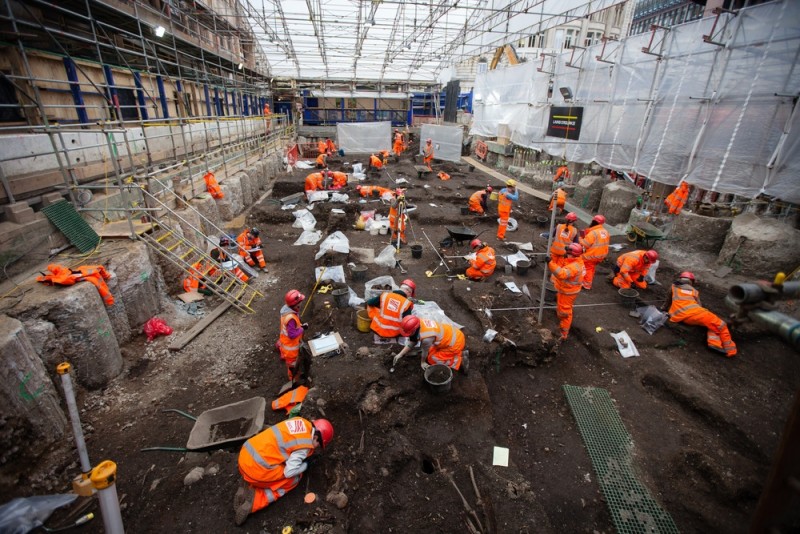As thousands died around him a Rye doctor sent letters back to friends in the town, and some of the bodies have been recently unearthed (above) with unexpected findings.
A fascinating and fascinated gathering took place at Rye Museum last Saturday (November 8) as academics and civilians met to discuss the events around the Great Plague of 1665. In the course of seven months, 100,000 people in London were dead, or 20% of the population. Many fled, taking the plague with them and spreading it throughout the country.
The conference was put together by Lara Thorpe, from Royal Holloway College at the University of London, and covered an eclectic variety of subjects, with Thorpe herself concentrating her research on the letters of John Allin.
Allin, a Rye priest and doctor, left the town after the restoration of the Catholic monarchy made it difficult for nonconformist Puritans. It was easier to pass unnoticed in London. Unfortunately for Allin, his departure for London coincided with the arrival of the plague.
He saw it as his calling to try to help and his experiences are chronicled in his letters back to Rye to his friends Samuel Jeake and Philip Frith. Allin was an interesting character. Like many in the medical profession, he was a fervent alchemist, using chemical experiments in search of the philosophers’ stone – a cure for disease, including the plague.
Marit Leenstra, an archaeologist from University College, London, in complete contrast, took us forward to the present day and the excavation of the burial ground at Bedlam, near Liverpool Street Station in London. The work began in March, prompted by the Crossrail project (a new underground railway under central London) to improve overloaded transport infrastructure.
More than 3,000 bodies have been found on the site, 200 of which have been taken away for DNA analysis, the rest reburied. Some intriguing discoveries have been made. For example no “plague pits”, which are mass graves for group burials, were found.
Instead, all the bodies were buried separately, in shrouds before 1600 and after that date, and during the plague years in coffins. This runs contrary to popular opinion. It is difficult to imagine how with that level of fatality and chaos, with people fleeing London in their droves, people still had the resources to bury their dead in such a respectful way.

The Bedlam cemetery was an overflow burial ground, established in 1569 in order to take bodies that the churches inside the city wall could not accommodate. It was built on half an acre of ground, bought from the Bedlam hospital, the notorious mental asylum.
The team of researchers had been able to deduce from burial registers what kind of people were buried there. These included women who had committed adultery, suicides, non conformist, strangers (which could include a person from Blackheath, or one from Africa) and plague victims.
Another thought provoking and entertaining speaker was Graham Twigg, who has written about the biological characteristics of the “plague”. He showed us how the plague spread from parish to parish and when. He described the habits and physiological aspects of the black rats responsible for spreading the disease. He told us how plague spread and about the incubation period.
As he spoke, many people wore quizzical expressions, some shaking their heads as his evidence seemed to contradict that of an earlier speaker and also popular conceptions of that time in history. But all became clear. Twigg presented powerful evidence that the “Great Plague” of 1665 was not really plague at all, but rather another epidemic and dangerous disease.
It is not known what that disease was as plague, like other diseases, leaves no trace on the skeleton, and typically DNA studies tend to test for plague and not for other alternatives. Even if bone testing shows traces of Yersinia pestis plague bacterium, this does not mean that they died of it. They may have died of something completely different such as anthrax or an ebola style disease.
Rebecca Rideal, a writer and television producer gave us some perspective, reminding us that there was a world outside plague, providing an interesting account of the second Anglo-Dutch war.
The museum will be holding its sixth biennial medieval conference on October 29 next year, entitled “Conspicuous Consumption and Display in Late Medieval England”. More information is available from info@ryemuseum.co.uk or by phone, 01797 226728.
Photos: Crossrail and Seana Lanigan



